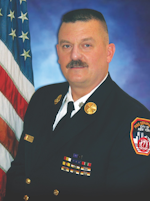When we arrive at a structural fire, one of the first actions we take, if possible, is to complete a 360-degree survey of the building. This is one of our first on-scene methods of collecting information about the situation we have been summoned to handle or solve.
Information is the incident commander’s greatest resource. With it, we are making decisions based on actual conditions; without it, we can be guessing.
What we need to know
Let’s look at how we gather information:
6 A.M. – We are alerted to respond to a report of smoke from a building at 161 Washington Ave. on a cool December morning. The dispatcher informs the responding units that the caller has reported smoke from a first-floor window in the rear of a private dwelling. This is our first serving of information. We have received it from the dispatcher, who in turn has received it from a citizen walking past the alarm location. This information is neither verified nor 100% reliable.
6:03 – The dispatcher updates us with more information. They are receiving numerous calls reporting a fire at that address. Additionally, one caller said a person may be trapped. The incident commander, upon receiving this update, orders the dispatcher to fill out the alarm with several more companies. Numerous calls reporting a fire tend to elevate the reliability of those calls.
6:05 – The first engine arrives and reports a working fire on the first floor of a two-story private dwelling, with fire threatening an exposed garage. They also report that there is a burn victim on the front lawn. This is now our third dose of information and the incident commander has not even arrived yet. The chief calls the dispatcher and requests an ambulance to the scene for the burned civilian.
6:06 – The battalion chief arrives at the scene and assumes command. After a rapid survey of the scene, he calls the first engine officer, who is inside the house with the nozzle team for a report of conditions. The engine reports several rooms of fire and that they are advancing into the fire area at this time. The chief looks at the side of the house where the flames are and sees that the garage is safe and too far from the house to be considered in danger. This little piece of information, gathered by the chief himself, corrects the earlier report that described the garage as threatened.
6:10 – The second unit arrives and the incident commander orders the team to the second floor for search. He informs the officer that there has been a report of people possibly trapped inside the house. He also asks the officer to check for any extension up to the second floor. The chief received no new information at this moment, but does pass some already known information (about the trapped person) to the second team.
6:11 – The incident commander makes another quick trip down the driveway to check the rear and discovers the fire issuing from one of the windows in the rear has spread up the siding of the house and is now burning under the eaves in the rear and entering a window on the second floor. This newest information, again gathered by the incident commander directly, is important and requires the ordering of another just-arriving engine company to stretch a hoseline to the second floor to handle the extension.
The incident commander also contacts the team on the second floor and asks for a report. They advise that they have searched rooms on the second floor and are making progress. They also report an increase in the heat and smoke conditions on the second floor. The incident commander warns the team that fire may be getting into the rear second-floor window near the B/C corner. The incident commander has now received more information, this time from the team on the second floor. Note also that the incident commander had to ask for a report. Sometimes, information is out there waiting for you to look for it.
6:14 – The first engine reports fire extinguished and they are searching for more. The incident commander asks the first engine to look at the rear of the house and extinguish any fire burning up the exterior siding. The team on the second floor calls the incident commander and states, “Ceilings down on the second floor, no extension to the attic.”
6:22 – The fire is extinguished.
Information gathering starts upon receipt of the alarm and continues until the fire is under control. Gathering, deciphering and relaying information is a continuous activity. Every radio report, every visual and every transmission from the dispatcher is a dose of information for you to apply to the scene you are commanding.
John J. Salka Jr. presents “You Are Not In the Front Seat to Beep the Horn” at Firehouse World 2014.

John J. Salka Jr. | Battalion Chief
JOHN J. SALKA JR., who is a Firehouse contributing editor, retired as a battalion chief with FDNY, serving as commander of the 18th battalion in the Bronx. Salka has instructed at several FDNY training programs, including the department’s Probationary Firefighters School, Captains Management Program and Battalion Chiefs Command Course. He conducts training programs at national and local conferences and has been recognized for his firefighter survival course, “Get Out Alive.” Salka co-authored the FDNY Engine Company Operations manual and wrote the book "First In, Last Out–Leadership Lessons From the New York Fire Department." He also operates Fire Command Training, which is a New York-based fire service training and consulting firm.





